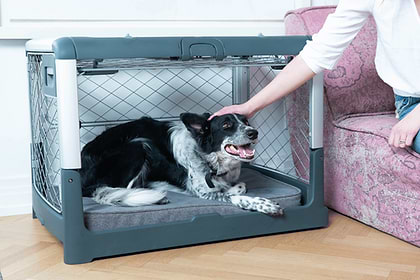With a countless number of languages around the world, humans still manage to find ways to communicate with each other. How? Through the use of hand signals, or the understanding of root words. This works the same with dogs and other pets; you just need to know what to look out for.
Instead of using verbal, vocal commands, dogs use their body language as a preferred indicator to what they want, need, or are right out getting your attention for. Dogs provide signs that are physiological, behavioral, or of pain and discomfort. Learn what cues your pup is giving you and how to both understand and react to these signals to keep your fur baby happy.
#1: Changing Eating and Drinking Habits
It’s dinner time. You go to your pup’s food bowl but notice there’s still food there. Was your pup not hungry all today?
This could be a sign that your dog caught a harmless bug and it needs to run its course through their system. Or, it could be a sign that medical attention is necessary. Monitor the symptoms. If they last more than 24 hours, contact your veterinarian for help.
#2: Does It Feel Like Somebody's Watching You?
If you are getting that feeling that you are being watched, take a look around. It could be your dog that is staring at you. Now to figure out why. This may take some time to determine, but your dog is acting this way for one of four reasons including attention, confusion, desire, or direction.
- Attention: This one is straightforward. If your dog is staring at you, they may want your attention. Give them belly rubs. Grab their favorite toy and play with them. Go for a walk. Any type of affection should do.
- Confusion: Since humans and dogs can’t speak to each other through words, dogs watch humans closely. Just like you try to read your dog's behavior, your dog is doing the same with you. Your dog carefully examines you, interpreting to the best of their ability what it is you want from them, or how you want them to act or respond. So if you are displaying behavior that they don’t understand, they may be staring at you with curiosity.
- Desire: When dogs want something, they stare at you with the hope that you’ll understand what they are after. For example, are they staring with their favorite toy in their mouth? If so, it could mean they are waiting for you to get the hint that they want to play.
- Direction: If your dog doesn’t know what to do next, they could be staring at you patiently waiting for you to give them a command. This is frequently displayed when a dog is actively training.
#3: Whimpering and Whining
Your dog could be trying to get your attention vocally by whimpering or whining. Dogs do this when they want attention or when they need something. They also do this when they are feeling stressed, scared, or worse—when they are experiencing pain.
Observe your dog and be aware of your surroundings. Look for signs of change or distress. This helps you identify what your dog is trying to tell you, or asking you for.
#4: Accidents Happening More Frequently
Especially if your dog is potty trained, it is easy to think that your dog is behaving badly when accidents occur in the household. Try to hold your reaction and assess the situation first. Your dog may actually be trying to tell you that something is wrong, or that they are not feeling themselves.
If your dog is suddenly experiencing accidents in the house, seek out help from your vet.
A mental illness known as separation anxiety is also known to cause dogs to relieve themselves indoors, even after they are trained. If your dog gets upset or anxious, you can consider setting up living quarters for them in a closed-off area to help with the clean-up when you arrive home.
If your dog is suddenly experiencing accidents in the house, seek out help from your veterinarian. Your vet can help you determine the cause behind the accidents and provide treatment if necessary.
Dogs love routine. When that routine is interrupted or if it suddenly changes, their behavior may follow. Dog’s easily get confused and may need redirection or a reminder of the rules.
Change takes form in numerous ways. For example, did you recently move? In a new home or setting, dogs can return back to their roots and mark their territory. Did you recently change jobs or obtain a new work schedule? Be patient and practice the new schedule with your dog. They will grow accustomed to it soon enough.
If change leads to your dog having accidents indoors, take the time to point out the dos and don'ts of the household to get them back on track.
#5: Repetitive Licking and Scratching
Just like humans, dogs can have allergies. A sign your dog is combating an allergy is through consistent licking and scratching behaviors.
If you are curious, there are many different types of allergies that dogs experience. Identifying the allergy starts the process of providing comfort and relief for your dog.
Skin Allergies
The most common type of skin allergy relates to flea bites. An attack from a tiny flea causes severe itching. The inflammation, redness, or scabbing of the skin may also result from a bite. Contact your vet to identify the type of skin allergy and the form of treatment.
Food and environmental allergies also cause skin irritation. Irritation also leads to a secondary infection should your dog create and open a wound.
Food Allergies
Food allergies and food sensitivity are different but carry similar symptoms. Work with your veterinarian to diagnose whether your dog has a true food allergy, or if it is a food sensitivity.
Food allergies cause immune system reactions. If your dog is having an allergic reaction, check for the following signs:
- Skin irritation such as hives, swelling, and itchiness
- Vomiting or diarrhea
To combat food allergies, you’ll need to place your dog on a hypoallergenic diet, or a whole food recipe. It’s all formulated based on what your dog is allergic to.
Environmental Allergies
Environmental allergies also carry the fancy name of atopic dermatitis or atrophy. They may be hereditary, but that’s not always the case. Pets can have allergies to pollen, dust mites, grasses, etc. They can be seasonal or carried throughout the year.
#6: Destructive Behavior
Coming home after a long day and finding your furniture was torn or your socks chewed up is upsetting. Before you get angry though, do you know why your pet may behave in this manner? You may be able to correct this behavior, depending on its driving force.
Sometimes, when your dog experiences separation anxiety, this behavior is displayed. Other times it is because your dog gets bored. Puppies are notorious for this. Just like a child, dogs need physical exercise and mental stimulation on a daily basis. Introduce more playtime, walks, and interactions into your dog's day to curb the habit of destruction.
#7: To Pet or Not To Pet?
Dogs can be irresistible sometimes, especially to dog lovers like yourself. But reaching out to pet a dog could exhibit signs that they are injured or experiencing discomfort. Other times, a positive reaction occurs and the affection cycle starts. Look for the signals your dog gives to know which is about to happen.
Hesitation
As you approach your dog and gear up to give them love and affection, they pull away or flinch. This could be a sign that they are experiencing pain or discomfort, or it could be their way of telling you they don’t want to be bothered. Which is it? It’s easier to tell if you pay close attention to your dog and are familiar with their normal behavior.
Displaying the Stomach
Did your pup just come by you, lay on their back, and fully expose the belly? Don’t worry; not all behavior cues are negative! This one relates to trust. Yes, your pup is telling you that they confide in you. They are also telling you that it's time for a belly rub. Look to see that your pup's legs are in an upward position and that the tail is tucked up towards the belly.
When you see this behavior, stop and take a moment to embrace the need for love and attention your pup is craving.
The Bottom Line
When your dog needs something, good or bad, they won’t hesitate to let you know. Dogs find a way to communicate with you so keep your eyes and ears open. Your dog’s body language and vocal cues tell you a lot about how your dog is feeling.
Keeping your pet safe, comfortable, and happy is simple with the help of Diggs Pet. Visit Diggs Pet to see how you can introduce luxury and comfort to your home. Your dog will thank you for it.
Sources:
5 Ways Your Dog Asks For Help | The Dog People by Rover.com
14 Ways Your Dog May Be Asking for Help
Dog Allergies: Symptoms and Treatment – American Kennel Club

The Diggs Team
We believe our dogs deserve safer, better designed pet products.
You might also like
Crate training tips, stories and inspiration
View all blogsIn Your Diggs
Share your photos with #DiggsPet and tag us @DiggsPet on IG and TikTok.



